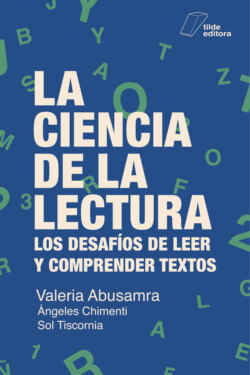Читать книгу La ciencia de la lectura - Valeria Abusamra - Страница 17
На сайте Литреса книга снята с продажи.
BIBLIOGRAFÍA
ОглавлениеAdams, M. J. (1990). Beginning to read: Thinking and learning about print. Cambridge: MIT Press.
Adams, M., Foorman, B. R., Lundberg, I. y Beeler, T. (2002). Phonemic Awareness in Young Children. Baltimore, Maryland: Paul H. Brookes Publishing.
Borzone, A. M. y Diuk, B. (2010). Conocimiento de vocabulario, representaciones fonológicas y sensibilidad fonológica en niños pequeños de distinto sector social de procedencia. SUMMA Psicológica US, 7(1), 33-50.
Borzone, A.M., Marder, S. y Sánchez, D. (2015). Leamos juntos: Cuadernillo para el alumno. Programa para el aprendizaje acompañado de la lectura y la escritura inicial. Buenos Aires: Paidós.
Bruner, J. (1966). Toward a Theory of Instruction. Massachusetts: Harvard University Press.
Burgess, S. R., Hecht, S. A. y Lonigan, C. J. (2002). Relations of the home literacy environment (HLE) to the development of reading-related abilities: A one-year longitudinal study. Reading Research Quarterly, 37(4), 408–426.
De Bruin-Parecki, A. (2007). Let´s Read Together. Improving Literacy Outcomes with the Adult-Child Interactive Reading Inventory. Baltimore: Paul Brookes Publishing co.
Feitelson, D. y Goldstein, Z. (1986). Patterns of book ownership and reading to young children in Israeli school-oriented and nonschool-oriented families. Reading Teacher, 39, 924-930.
Flores, R. (2019). A Look at Chinese Parents’ Literacy Practices and Their Preschool Children’s Literacy Experiences. Creative Education, 10, 2013-2027.
Gunning, T. (1998). Assessing and Correcting Reading and Writing Difficulties. Boston: Allyn and Bacon.
Halliday, Ch. (1988). Spoken and Writing Language. Hong Kong: Oxford University Press.
Lonigan, Ch. (2006). Conceptualizing Phonological Processing Skill in Preaders. En S. Newman and D. Dickinson (Eds.). Handbook of Early Literacy Development (Vol 2). New York: Guilford.
Martinet, A. (1970). Elementos de lingüística general. Madrid: Gredos.
Moats, L. C. (2010). Speech to Print. Language Essentials for Teacher (2nd edition). Baltimore, Maryland: Paul H. Brookes.
Morais, J. (1998). El arte de leer. Madrid: Visor.
National Reading Panel. (2000). Teaching Children to Read: An Evidence-Based Assessment of the Scientific Research on Reading and its Implications for Reading Instruction. U.S. Department of Health and Human Services. Recuperado de: http://www.nichd.nih.gov/publications/nrp/report.cfm
OCDE (2016). The Survey of Adult Skills: Reader’s Companion, Second Edition. OECD Skills Studies. Paris: OECD Publishing.
Payne, A. C., Whitehurst, G. J. y Angell, A. L. (1994). The Role of Home Literacy Environment in the Development of Language Ability in Preschool Children from Low-income Families. Early Childhood Research Quarterly 9, 427-440.
Piacente, T. (2005). Las habilidades y conocimientos prelectores. Su incidencia en el aprendizaje formal. En J. Vivas (Ed.). Las ciencias del comportamiento en los albores del siglo XXI (pp. 63-73). Mar del Plata: Universidad Nacional de Mar del Plata.
Piacente T. (2018). De la alfabetización inicial a la alfabetización académica. Las demandas cognitivas implicadas en el aprendizaje del lenguaje escrito. En UCALP. Proyecciones Disciplinares del Humanismo. La Plata: Editorial UCALP.
Piacente, T., Marder, S., Resches, M. y Ledesma, R. (2006). El contexto alfabetizador hogareño en familias de la pobreza. Comparación de sus características con las de familias no pobres. Revista Iberoamericana de Diagnóstico y Evaluación Psicológica, 1(21), 61-88.
Piacente, T y Tittarelli, A. M. (2009). La lectura de cuentos dialógica y las características de la interacción según estrato social de procedencia. Evaluar. Laboratorio de Evaluación Psicológica y Educativa, 9, 1-18.
Raz, I. T. y Bryant, P. (1990). Social background, phonological awareness and children’s reading. British Journal of Developmental Psychology, 8(3), 209-225.
Rosemberg, C., Alam, F., Audisio, C.P., Ramírez, M.L., Garber, L. y Migdalek, M. J. (2020). Nouns and verbs in the linguistic environment of Argentinian toddlers: Socioeconomic and context-related differences. First Language, 1-26.
Rowe, M. L. (2012). A longitudinal investigation of the role of quantity and quality of child-directed speech in vocabulary development. Child Development, 83, 1762–1774.
Samspon, G. (1997). Sistemas de escritura. Análisis lingüístico. Barcelona: Gedisa.
Segui, J. y Ferrand, L. (2000). Leçons de Parole. Paris: Editions Odile Jacob.
Signorini, A. (2000). Del habla a la escritura. El procesamiento fonológico en la lectura inicial. Tesis Doctoral (inédita). Facultad de Humanidades y Ciencias de la Educación, Universidad Nacional de La Plata .
Snow, C. E., Burns, M. S. y Griffin, P. (Eds.) (1998). Preventing reading difficulties in young children. Committee on Prevention of Reading Difficulties in Young Children, Commission on Behavioral and Social Sciences and Education, National Research Council. Washington, DC: National Academy Press.
Snow, C.E. y Juel, C. (2005). Teaching Children to Read: What Do We Know about How to Do It? En M. J. Snowling y Ch. Hulme (Eds.). The Science of Reading: A Handbook (pp.501-520). Malden, MA: Blackwell Publishing.
Stein, A., Menti, A.B. y Rosemberg, C. (2021). Socioeconomic status differences in the linguistic environment: a study with Spanish-speaking populations in Argentina. Early Years. An International Research Journal, 1-12.
Torgesen, J. K. y Mathes, P. G. (2002). A Basic Guide to Understand, Assessing, and Teaching Phonological Awareness. Austin, Texas: Pro-De International Publisher.
Uccelli, P., Demir-Lira, L., Rowe, M., Levine, S. y Goldin-Meadow, S. (2018). Children’s Early Decontextualized Talk Predicts Academic Language Proficiency in Midadolescence. Child Development, 90 (5), 1650-1663.
Vigotsky, L. (1978). Thought and language. Cambridge Mass.: MIT Press. Traducción en español (1973): Pensamiento y lenguaje. Buenos Aires: La Pléyade. (Trabajo original de 1934).
Wagner, R. K., Torgesen, J. K., Laughon, P., Simmons, K. y Rashotte, C. A. (1993). Development of young readers’ phonological processing and its causal role in the acquisition of reading skill. Psychological Bulletin, 101, 192-212.
Whitehurst, G. J. (2000). The NCLD Get Ready to Read technical report. Unpublished Report. State University of New York at Stony Brook.
Whitehurst, G. J. y Lonigan, C. J. (1998). Child development and emergent literacy. Child Development 69, 848-872.
Whitehurst, G. J. y Lonigan, C. J. (2001). Emergent literacy: Development from prereaders to readers. En S. Newman y D. Dickinson (Eds.). Handbook of Early Literacy Development (Vol 1). New York: Guilford.
Whitehurst, G. J. y Lonigan, C. J. (2003). Get Ready to read! An Early Literacy Manual: Screening Tool, Activities, & Resources. New York: Pearson Early Learning.
